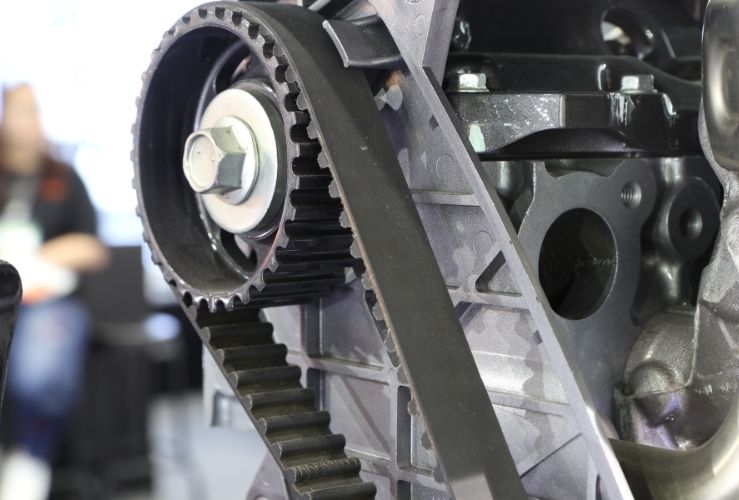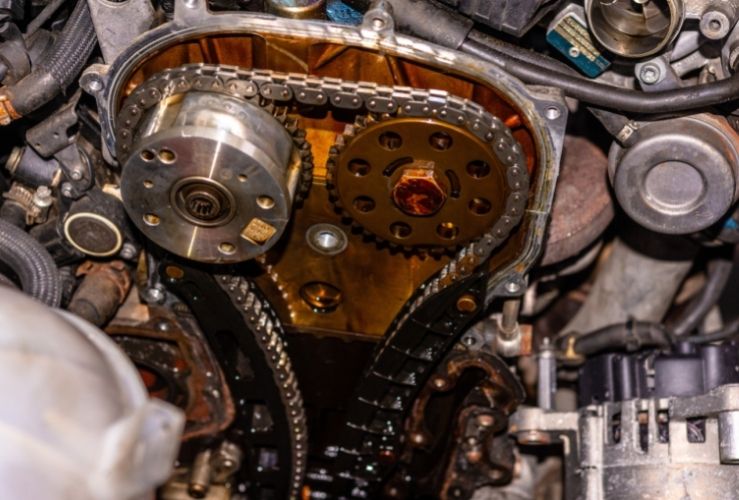What are timing belts? What do timing belts do?
In short, a timing belt has teeth that turn an engine’s camshaft in time with the crankshaft.
The timing belt is essential for the smooth running of your engine.

Timing belt purpose
Expanding further as to what does a timing belt do, the primary purpose of the timing belt is to synchronise the movement of the engine’s camshaft and crankshaft, ensuring precise timing of the valves.
This allows the engine’s combustion process to happen in an orderly manner, contributing to optimal performance. Without a properly functioning timing belt, the engine would not operate efficiently and could incur significant damage.
Timing belts in more detail
On most internal combustion engines, the crankshaft - which is connected to the pistons - spins around.
The crankshaft is connected to the camshaft, which opens and closes the valves.
There are different ways to connect the crankshaft and camshaft - but mostly it's either a timing belt, or timing chain/variable-valve system.
In very old cars, a series of gears made this connection. But manufacturing costs and noise meant they gave way to timing chains, then to cheap timing belts made of rubber.
Due to the failure rate of rubber timing belts, many carmakers switched back to more durable timing chains/variable valve timers.
The improved durability of timing chains meant carmakers began making interference engines again, instead of non-interference ones (see below).
Interference engine timing belts
In the case of an interference engine, the timing belt needs to be in good working order to prevent engine damage.
A broken timing belt will cause the pistons to hit the valves, damaging the engine - usually beyond repair.
Rubber timing belts are liable to breakage, while timing chains should last much longer.
Non-interference timing belts
If you have a non-interference engine, a broken timing belt will not cause damage to the engine. However, if it breaks while you're driving, you'll end up stranded.
While you may save money by leaving the belt until it breaks, you’ll probably have to deal with the hassle and cost of recovery later on.

Variable-valve timing engine
More modern cars are often fitted with variable-valve timing systems, which use chains to regulate the engine timing.
Timing chain: What is the difference between a timing chain and a timing belt?
Similarly to a timing belt, the timing chain is used to synchronize the movement of certain parts in the engine. The only difference might be that the timing belt can drive the water pump on some car models.
What are the benefits of a timing chain?
- As long as you change the oil and filter regularly, the chain should last for the lifetime of the car
- A timing chain does not require any maintenance, apart from carrying out a check after reaching 125,000 miles.
- The metal in the timing chain is resistant to temperature changes, unlike the rubber used in timing belts.
How long do timing chains typically last?
Timing chains are built to be much more durable than rubber timing belts. With regular oil and filter changes, a timing chain can last the entire lifespan of the car, often exceeding 200,000 miles.
While there is no specific timeline for replacement, a check-up may be recommended once the car has surpassed 125,000 miles. Unlike belts, timing chains are far less likely to snap, providing reliable synchronisation over a longer period. That said, timing chains are not infallible and can require replacing, especially in high-mileage vehicles.
When to change a timing belt
Swapping out your timing belt is an expensive job, so you don't want to do it if you don’t need to.
So when should you change your timing belt?
Cars that are heading towards 10 years old or have 70,000+ miles on the clock probably require a new timing belt.
Ideally you would change your timing belt every 5-6 years. While every timing belt has a mileage specification, once they get old, the chance of failure increases greatly.
Since the timing belt is housed next to the engine and is made of rubber, over time cracks will develop and it will break.
How do I know if my timing belt needs changing?
Sometimes, your timing belt may need replacing earlier than expected.
If your car won’t start, this could be due to an issue with the timing belt. Additionally, engine noises could be an indication that your belt is about to fall. Screeching or whirring sounds indicate that the timing belt is beginning to slip or has become misaligned, whilst a clicking or ticking noise is a common sign that your timing belt may be about to fail.
Unscrupulous garages
It has been known for unscrupulous garages to charge for a new timing belt when the vehicle actually has a chain (variable-valve).
It is therefore a good idea to know if your car has a timing belt, or timing chain/variable value system - just in case.
Consider belt type when buying a car
If you’re in the market for a new or used car, it’s a good idea to ask about the timing belt.
Cars with rubber timing belts will require belt replacement at some point, while those with a timing chain/variable-valve system are unlikely to need replacing (assuming engine oil and filters are changed regularly, as mentioned).
Cars with timing chains in the UK
There are many cars available in the UK automotive market which have timing chains.
Most BMW’s and Mercedes are fitted with timing chains. Other popular car models in the UK that are fitted with timing chains include the Honda Jazz, Dacia Duster, Jaguar X-Type and most Minis.
Can you change the timing belt yourself?
You would need significant mechanical knowledge to change a timing belt yourself.
The main challenge is accessing the old timing belt, which - depending on the model - may involve the removal of fan/drive belts; front motor mount; water pump pulley; timing belt cover; crankshaft pulley; and idler pulley.
While you're there you might also replace the drive belt, saving time and effort later on.
But for most car owners, it’s much easier to simply enlist a trained mechanic to change the timing belt.
Timing belts only cost about £30, but labour will add to the final bill.
Frequently Asked Questions
If a timing belt snap occurs while driving, the engine’s pistons and valves will likely collide, causing severe internal damage. In an interference engine, this may require a complete engine replacement, as the broken timing belt can lead to bent valves, damaged pistons, and other costly repairs.
In a non-interference engine, while there is no internal damage, you would still be stranded and would need to call on the assistance of your breakdown cover provider. This is why it's crucial to replace the timing belt at recommended intervals to avoid sudden failure.
Determining the right timing belt for your car depends on your vehicle’s make, model, and engine type. Each car has a specific timing belt size and design that ensures compatibility with its engine components.
Consulting your car’s manual or a professional mechanic is the best way to identify what timing belt you need to keep your engine running smoothly.
Replacing a timing belt can cost between £200 and £1,000, depending on the vehicle’s make and model. The timing belt itself is relatively inexpensive — often around £30 — but labour costs add significantly to the final bill, as a timing belt is challenging to access. Knowing costs can help you plan for this maintenance expense and avoid unexpected repair costs.




